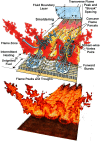Role of buoyant flame dynamics in wildfire spread
- PMID: 26183227
- PMCID: PMC4538634
- DOI: 10.1073/pnas.1504498112
Role of buoyant flame dynamics in wildfire spread
Abstract
Large wildfires of increasing frequency and severity threaten local populations and natural resources and contribute carbon emissions into the earth-climate system. Although wildfires have been researched and modeled for decades, no verifiable physical theory of spread is available to form the basis for the precise predictions needed to manage fires more effectively and reduce their environmental, economic, ecological, and climate impacts. Here, we report new experiments conducted at multiple scales that appear to reveal how wildfire spread derives from the tight coupling between flame dynamics induced by buoyancy and fine-particle response to convection. Convective cooling of the fine-sized fuel particles in wildland vegetation is observed to efficiently offset heating by thermal radiation until convective heating by contact with flames and hot gasses occurs. The structure and intermittency of flames that ignite fuel particles were found to correlate with instabilities induced by the strong buoyancy of the flame zone itself. Discovery that ignition in wildfires is critically dependent on nonsteady flame convection governed by buoyant and inertial interaction advances both theory and the physical basis for practical modeling.
Keywords: buoyant instability; convective heating; flame spread; wildfires.
Conflict of interest statement
The authors declare no conflict of interest.
Figures





Comment in
-
Breakthrough in the understanding of flaming wildfires.Proc Natl Acad Sci U S A. 2015 Aug 11;112(32):9795-6. doi: 10.1073/pnas.1512432112. Epub 2015 Aug 3. Proc Natl Acad Sci U S A. 2015. PMID: 26240316 Free PMC article. No abstract available.
-
Fires: fund research for citizen safety.Nature. 2017 Nov 16;551(7680):300. doi: 10.1038/d41586-017-06020-6. Nature. 2017. PMID: 29144471 No abstract available.
References
-
- Drysdale D. An Introduction to Fire Dynamics. 2nd Ed. John Wiley & Sons; New York: 1998. Chap 7.
-
- Sullivan AL, Ball R. Thermal decomposition and combustion chemistry of cellulosic biomass. Atmos Environ. 2012;47:133–141.
-
- Finney MA, Cohen JD, McAllister SS, Jolly WM. On the need for a theory of wildland fire spread. Int J Wildland Fire. 2013;22(1):25–36.
-
- Sullivan AL. Wildland surface fire spread modeling, 1990–2007. 1. Physical and quasi-physical models. Int J Wildland Fire. 2009;18(4):349–368.
-
- Marlon JR, et al. Climate and human influences on global biomass burning over the past two millennia. Nat Geosci. 2008;1:697–702.
Publication types
MeSH terms
LinkOut - more resources
Full Text Sources
Other Literature Sources

